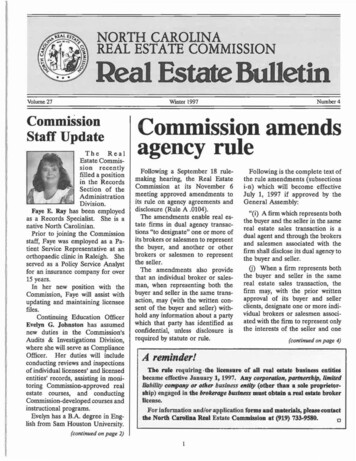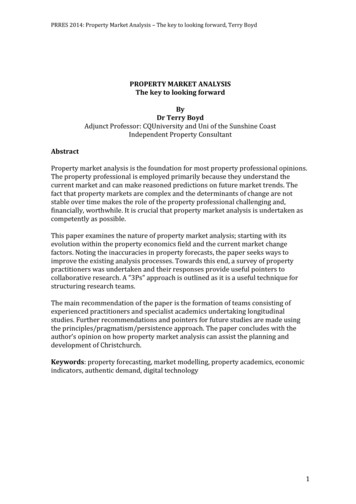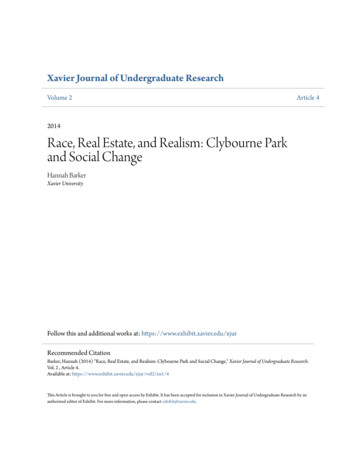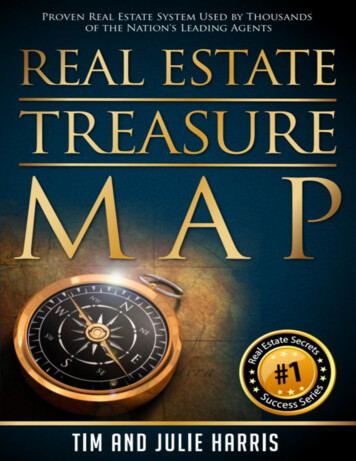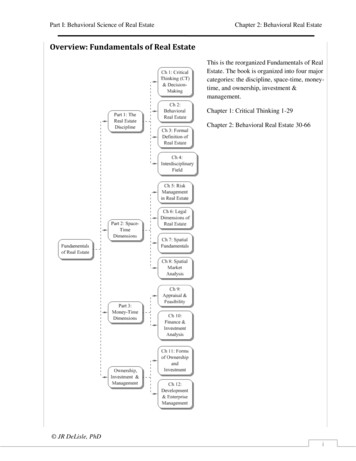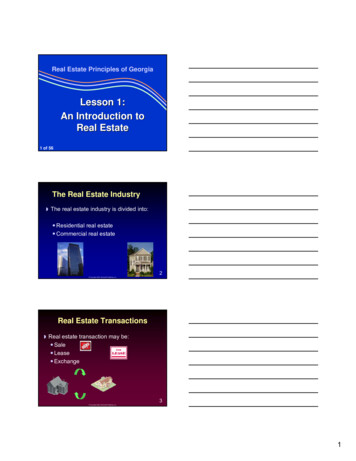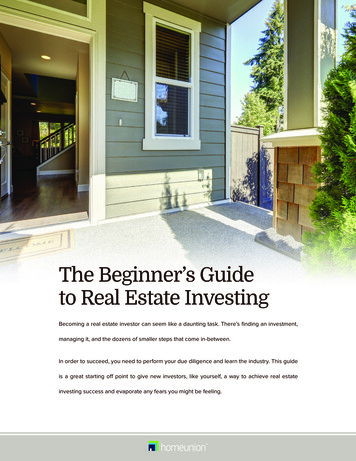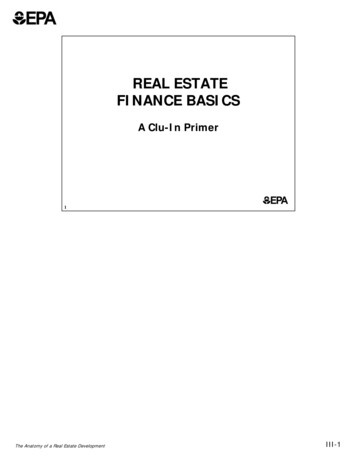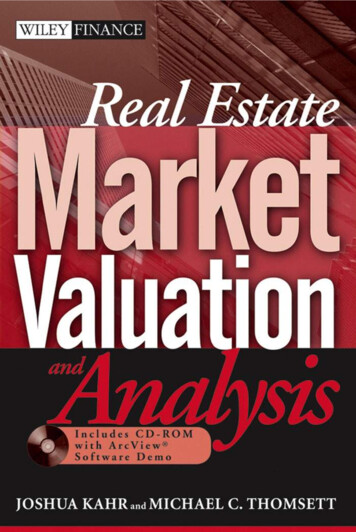
Transcription
Real EstateMarket Valuationand AnalysisJOSHUA KAHRandMICHAEL C. THOMSETTJohn Wiley & Sons, Inc.
Real EstateMarket Valuationand Analysis
Real EstateMarket Valuationand AnalysisJOSHUA KAHRandMICHAEL C. THOMSETTJohn Wiley & Sons, Inc.
Copyright 2005 by Joshua Kahr and Michael C. Thomsett. All rights reserved.Published by John Wiley & Sons, Inc., Hoboken, New Jersey.Published simultaneously in Canada.No part of this publication may be reproduced, stored in a retrieval system, or transmitted inany form or by any means, electronic, mechanical, photocopying, recording, scanning, orotherwise, except as permitted under Section 107 or 108 of the 1976 United StatesCopyright Act, without either the prior written permission of the Publisher, or authorizationthrough payment of the appropriate per-copy fee to the Copyright Clearance Center, Inc.,222 Rosewood Drive, Danvers, MA 01923, 978-750-8400, fax 978-646-8600, or on theweb at www.copyright.com. Requests to the Publisher for permission should be addressedto the Permissions Department, John Wiley & Sons, Inc., 111 River Street, Hoboken, NJ07030, 201-748-6011, fax 201-748-6008, or online at http://www.wiley.com/go/permissions.Limit of Liability/Disclaimer of Warranty: While the publisher and author have used theirbest efforts in preparing this book, they make no representations or warranties with respectto the accuracy or completeness of the contents of this book and specifically disclaim anyimplied warranties of merchantability or fitness for a particular purpose. No warranty maybe created or extended by sales representatives or written sales materials. The advice andstrategies contained herein may not be suitable for your situation. You should consult with aprofessional where appropriate. Neither the publisher nor author shall be liable for any lossof profit or any other commercial damages, including but not limited to special, incidental,consequential, or other damages.For general information on our other products and services, or technical support, pleasecontact our Customer Care Department within the United States at 800-762-2974,outside the United States at 317-572-3993 or fax 317-572-4002.Wiley also publishes its books in a variety of electronic formats. Some content that appearsin print may not be available in electronic books.For more information about Wiley products, visit our web site at www.wiley.com.Library of Congress Cataloging-in-Publication Data:Kahr, Joshua, 1974Real estate market valuation and analysis / Joshua Kahr and Michael C.Thomsett.p. cm—(Wiley finance series)Includes bibliographical references.ISBN-13: 978-0-471-65526-8 (cloth/cd-rom)ISBN-10: 0-471-65526-0 (cloth/cd-rom)1. Real property—Valuation. 2. Real estate investment. I. Thomsett,Michael C. II. Title. III. Series.HD1387.K3135 2005333.33'2—dc222005012597Printed in the United States of America.10 9 8 7 6 5 4 3 2 1
ContentsPreface A Practical ApproachviiCHAPTER 1The Essence of Analysis1CHAPTER 2Using Analysis Effectively29CHAPTER 3Valuation of Real Estate47CHAPTER 4Single-Family Home and Condo Analysis73CHAPTER 5Multi-Unit Rental Property Analysis99CHAPTER 6Retail Real Estate Analysis119CHAPTER 7Office and Industrial Real Estate Analysis145CHAPTER 8Lodging and Tourism Industry Real Estate161CHAPTER 9Mixed-Use Real Estate Analysis177v
viCONTENTSInternet Sources for Further Study195Bibliography207Glossary211Using a GIS Tool in Real Estate Market Analysis225Notes235Index241
Preface—A Practical Approach“ow much is it worth?”Every investor begins with this question. The question of value is atthe core of the decision. It is the essence of the decision to buy one propertyand to reject another.Value is a complex topic because it is partly subjective and partly determined by outside forces. A particular piece of property—whether residential, commercial, or industrial—will be valued based on its location,improvements, zoning, competition, local employment, and the availability(or lack of availability) of other, similar properties. For the serious analyst,the question should be, How is real estate value properly determined?There are numerous methods and theories available, some scientific andothers utilizing inaccurate statistical bases or national (rather than regionalor local) trends. We propose the use of scientific methods and, at the sametime, an overlay of practical considerations regarding local markets, risktolerance, cash flow, experience, tax benefits, and real estate-focused fundamental analysis. Just as stock investors recognize the importance of the fundamental analytical tools in the selection of stock, the same approach canand should be used in the analysis of real estate.It is neither possible nor advisable to try to determine value basedmerely on a visual inspection or other nonfundamental indicators. Such decisions are better made based on comparative shopping and analysis and athorough comparative approach to the entire real estate market. Ironically,some investors make a decision to purchase without careful and thoroughanalysis and, in some cases, without even defining the means for assigningvalue. For some consumers, a property is worth whatever its listed pricemay be, or whatever a real estate broker says. Considering that the sameconsumers are likely to purchase automobiles with greater care, this is apuzzling way to buy real estate. A car buyer will likely visit two or moredealers and, at the very least, take cars out for a test drive. Why comparison shop for 20,000 cars but impulse-buy a 250,000 investment property or residence?The example of the impulse-buying real estate buyer is the extreme.Most people are not that impulsive. However, real estate investors are facedwith the problem of how to analyze real estate values and, if they are toHvii
viiiPREFACE: A PRACTICAL APPROACHsucceed, they also need to develop the means for reliably analyzing the realestate they are considering buying. What factors determine value? Whatare the appropriate means for comparison between like-kind properties?Why does a subtle difference in location make a vast difference in price?These and similar questions are enormous challenges for the real estateinvestor. We cannot shop for property based on a single criterion, and wecannot limit our examination to the same criteria in all cases. For example,it is not prudent to shop for commercial rental property using the same valuation methods as we use when buying residential property. We cannoteven make the same underlying assumptions about two similar propertiesin different locations. The collective economic, demographic, and local factors affecting real estate values have to be studied and analyzed collectivelyif we are to make an informed decision. Real estate analysis can be performed by anyone; however, it is not enough to place trust in a broker orseller, and we cannot pick real estate from classified advertising. Those media are starting points in the search; informed decisions rely on more detailed analysis and study.It is a mistake to rely on others to identify value without further study.Even so, a vast number of investors do not ask the right questions or evenknow what questions to ask. Those who do inquire usually limit their dialogue to one with a real estate broker, who may not even be conversant inthe art of real estate analysis. Most state tests for real estate licensing aresurprisingly easy and require little in the way of actual analytical knowledge. Emphasis is usually placed on more mundane matters such as knowing how to fill in the standard forms for real estate contracts; agent andbroker liability and how to prevent it; and knowing about buyer and sellerrights and duties. Few real estate agents can provide advice on estimatingcash flow, analyzing relative value and investment potential, or the currentstate of local supply and demand.Even so, the buying public (including many mom-and-pop investors)presumes that the real estate broker has the answers. The broker’s job is tomove property onto the market, and the more properties they close, themore commission they earn. Emphasis is placed on bringing together awilling seller and a willing buyer. But as many prospective buyers oftenoverlook, the broker usually works for the seller. Consequently, so theprocess of real estate analysis—which is of greater interest to buyers thanto sellers—is not within the bundle of motivations that the broker has inmind. Therefore, if you do not know how to critically analyze real estatevalues and you depend on the assurances of a broker, you are on your own.This book addresses the problems of analyzing real estate with severalpossible readers in mind. A number of investors allocate a portion of theircapital to real estate through direct ownership, partnerships, or pooled in-
Preface: A Practical Approachixvestments (mortgage pools, for example, operate much like mutual funds,with portfolios consisting of mortgage debt rather than stocks or bonds).Business and real estate students and professors will also find this referenceto be valuable in developing—at the very least—an approach to issues ofvaluation and investment in real estate.The book has been organized to present material in a practical manner.What does this mean? Many years ago, a workshop was held at a conference for stockbrokers. One of the audience members asked a panel, “Howcan we do a better job helping our clients to make investment decisions?”One of the panel members advised, “Pretend it’s real money.”We are going to offer the same advice in this book. When we use theory by itself, we can have all of the answers. However, to make theorypractical, we also need to provoke thought within ourselves. We ask basicquestions and try to provide answers that may surprise many readers.Good rule-of-thumb advice, whether conceptual or practical, is valuable asa starting point; but we want to go beyond, to help our readers to think ofmoney invested in the real estate market as real money, and not just as anexercise in the theoretical process of investing.We begin with three chapters that discuss real estate analysis overall.These topics are essential for all investors, consumers, and students of realestate topics. Chapters 4 through 6 discuss specific popular types of property and isolate their unique features. The analysis of each type of real estate rests largely with the features each type of property contains. Thus,valuation of single-family residences (Chapter 4) will not be identical to theprocess of analysis for multi-unit properties (Chapter 5) or retail properties(Chapter 6). Chapters 7 through 9 examine valuation and means for analysis of nonresidential investment properties: office and industrial (Chapter7), lodging and tourism (Chapter 8), and mixed-use real estate (Chapter 9).Throughout the book, our goal has been to provide useful tools in theform of statistical information, examples, charts and graphs, and casestudies. The organization and format of the book is intended to ensure thatthe information can be absorbed and converted to practical applications.
CHAPTER1The Essence of AnalysisAnalysis is an elusive process; whether investor, appraiser, orstudent, understanding the essential points to consider is itself adifficult process. In this chapter, we introduce the fundamentalmethodology as a starting point for deciding whether aninvestment makes sense. We examine the question, Who usesmarket analysis and why? Finally, we demonstrate how raisingcapital for investment purposes must be premised on a foundationof solid analysis.nowing the right questions to ask is a wise starting point in any inquisitive task. Otherwise, we cannot identify the underlying assumptions necessary to arrive at an informed conclusion. A market analysis may haveseveral different meanings, just as a real estate market is not necessarily going to mean the same thing to different people. We recognize a definition ofreal estate market asKthe interaction of individuals who exchange real property rightsfor other assets, such as money. Specific real estate markets are defined on the basis of property type, location, income-producingpotential, typical investor characteristics, typical tenant characteristics, or other attributes recognized by those participating in theexchange of real property.1We also need to recognize that analysis may fall into several distinctand separate functions within the broad function of market analysis.1
2THE ESSENCE OF ANALYSISBASIC MARKET ANALYSIS CONCEPT—AN OVERVIEWWe view market analysis as a broad overview of supply and demand attributes for property, including site-specific and local factors and current aswell as emerging competition. To begin, we provide some basic definitions.Additional definitions may also be found in the book’s Glossary. Studiesthat focus on the market include:Analysis of local economies: Studies the fundamental determinants ofthe demand for all real estate in the market.Market analysis: Studies the demand for and supply of a particularproperty type in the market.Marketability analysis: Examines a specific development or property toassess its competitive position in the market.Studies that focus on individual decisions include:Feasibility analysis: Evaluates a specific project as to whether it islikely to be carried out successfully if pursued under a proposedprogram. May relate to developability. Most often related to financial feasibility.Investment Analysis: Evaluates a specific property as a potential investment. Usually incorporates specific financing in the analysis,and may evaluate alternative financing options to select most appropriate financing or consideration of income taxes. Emphasis ison risk and reward, sensitivity analysis, and internal rate of return.With these definitions in mind, the value of the market analysis becomes apparent. It is a study that tries to identify the market for a particular real estate product. W
Real estate market valuation and analysis / Joshua Kahr and Michael C. Thomsett. p. cm—(Wiley finance series) Includes bibliographical references. ISBN-13: 978-0-471-65526-8 (cloth/cd-rom) ISBN-10: 0-471-65526-0 (cloth/cd-rom) 1. Real property—Valuation. 2. Real estate investment. I. Thomsett, Michael C. II. Title. III. Series. HD1387.K3135 2005 333.33'2—dc22 2005012597 Printed in the .

